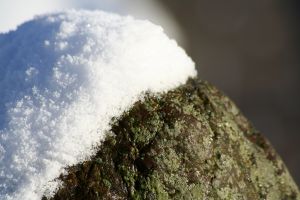Blankets of Snow: Snow as an Insulator in the Garden

El Nino or no, Mother Nature has seemed to have recovered her senses. Snow has settled on Cleveland and the surrounding area like a cat on a TV.As you may know, I am not a big fan of the white stuff. This is, regrettably, seen to be a deficit in character among my husband’s family, who would take a weekend in Tahoe over a week in Florida any time of the year, provided that Tahoe had snow and Jimmy Buffet happened to be out of the state on tour. Granted, they view my chionophobia as a flaw that can be overlooked, but it is a flaw none the less.
*sigh* So I do my best to find the good in snow, for the sake of family relations.
Fortunately for me, as a gardener, snow has some redeeming qualities. There is hope for me yet.
One can think of snow like Mother Nature’s insulation… except it’s not pink, it is easier to remove and you don’t have to worry about itching all over after you have been rolling around in it naked. Of course why you would be rolling around naked in fiberglass insulation or the snow is really something you need to keep to yourself so let’s get back to the subject at hand, shall we?
As a gardener, if you were given the choice between weather that was 30F and clear or 25F and snowing, which would you choose? If you chose snow, you chose wisely. Plants that are cuddled up in the ground under a nice blanket of snow are more likely to survive than plants that have nothing but dirt skivvies to protect them.
I know on the surface this makes no sense. Snow only forms when water vapour passes through temps that are below freezing i.e. snow is frozen water i.e. snow is ice. We all know that ice is bad for plants, so ergo snow = really dead plants. Logically this makes sense but in reality we would be WRONG!
The flaw in our logic come in under the fact that snow is not in fact 100% ice. In fact, new fallen snow is only about 7% ice. The other 93% is made up of the multipurpose gas we generally call air. The two combined together make a very good insulator. As a matter of fact, about two inches of snow insulate as well as one inch of that itchy pink stuff you have in the attic.
The ice in snow is made up of very lovely crystalline shapes called snowflakes. These flakes pile and lock together and create pockets that trap air in between them. Because the air can’t move, it has a hard time transferring heat or cold. On top of that, ice is actually a really poor conductor of heat. The heat trapped in the ground has no where to go. The air trapped in the snow can’t rise up and cool down and the ice doesn’t do a very good job of drawing the heat up. So the ground, anything in the ground and anything trapped between the snow and the ground stay relatively warm.
And if this were a perfect world the story would end there and we would pack snow around our plants instead of straw. But it is not, so you had better keep reading before you tell the kid shoveling the driveway to bury your prize rosebushes.
Snow does one little teeny thing that keeps it from being a really great insulator. It melts. While it doesn’t do a great job of drawing heat up, it does happen. A warm spell in the weather can do it as well. The snowflakes’ crystal structures start to break down and the pockets of air get smaller and smaller (less insulating and less insulating) till either you have a puddle or it gets cold again and then you have… you guessed it… ice (remember, ice – bad for plants).
Your plants are actually better off having a winter where you have snow and the temps stay in the 20F’s than you are a winter where the temps fluctuate above and below the freezing point (provided you live in a climate that is suppose to have a cold winter) .
Though it pains me to do it, I suppose I should be glad that the snow is here and pray that the weather stays cold. I suppose it is pretty to look at. At least until the first day of Spring and then all of this damn snow had better be gone.

Pingback: Multiple Choice Question for Gardeners | St John Indiana Garden Club